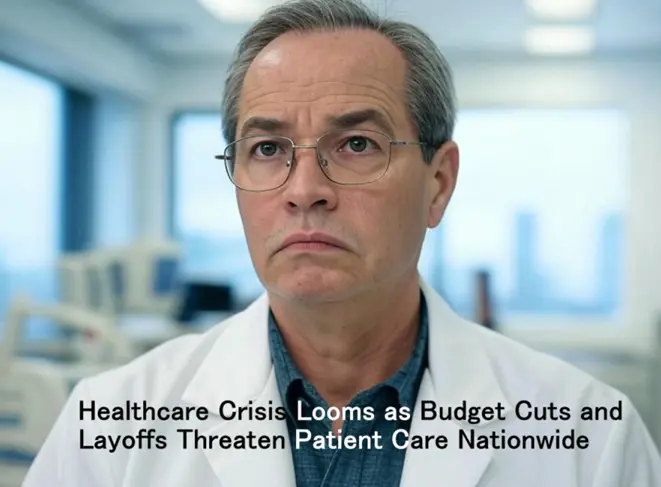
Healthcare Crisis Looms as Budget Cuts and Layoffs Threaten Patient Care Nationwide
Budget Cuts, Leadership Shifts, and the Future of Patient Care
The U.S. healthcare system is at a crossroads. As financial pressures mount, hospitals are cutting jobs, federal agencies are facing layoffs, and policymakers are debating the future of Medicaid funding. Meanwhile, regulatory reforms and leadership changes are setting the stage for a healthcare landscape in flux. In this article, we explore the latest developments shaping the industry and what they mean for patients and professionals alike.
Medicaid Cuts: A Looming Crisis for Healthcare Access
Healthcare executives recently gathered in Washington, D.C., to voice their opposition to proposed Medicaid cuts that could significantly impact care accessibility. These reductions could leave millions of vulnerable patients without adequate medical support, particularly those in underserved communities. Hospitals that rely on Medicaid reimbursements for operational costs fear that the cuts will force them to reduce services or shut down entirely.
Why It Matters: If these cuts go through, hospitals will be under greater strain, emergency rooms could become overcrowded, and patient outcomes may suffer. Many industry leaders argue that rather than reducing Medicaid funding, policymakers should focus on strengthening the program to ensure continued access to essential care.
Hospital Closures and Workforce Furloughs: A Growing Concern
In a distressing trend, hospitals across the country are pausing services and furloughing employees. Insight Hospital and Medical Center Trumbull, along with Hillside Rehabilitation Hospital in Ohio, have temporarily ceased operations, leaving their entire workforce without jobs. These closures are part of a larger pattern, with over two dozen hospitals either downsizing or cutting jobs in response to financial pressures.
The Bigger Picture: The closure of hospitals and job cuts not only affect healthcare professionals but also have a devastating impact on patients who rely on these institutions for critical care. Rural and community hospitals are particularly at risk, as they often operate on thin financial margins and lack the financial buffers of larger health systems.
HHS Layoffs: A Blow to Public Health Programs
Starting April 1, employees at the U.S. Department of Health and Human Services (HHS) began receiving dismissal notices as part of a plan to lay off 10,000 workers. This reduction could significantly weaken public health initiatives, affecting everything from disease control programs to Medicare and Medicaid administration.
Industry Response: Public health experts warn that these layoffs could hamper the country's ability to respond to emerging health crises. With fewer workers to manage essential programs, patients may experience longer wait times, reduced support services, and diminished access to resources.
Regulatory Changes: The Justice Department Takes Aim at Market Barriers
In a bid to promote competition in healthcare, the U.S. Department of Justice has launched a task force to eliminate regulations that hinder market entry and innovation. Many experts argue that excessive red tape limits the ability of new healthcare providers to compete, driving up costs for consumers.
What This Means for You: Reducing unnecessary regulations could lead to lower healthcare costs, greater innovation, and improved patient care. However, it will be crucial to balance deregulation with maintaining patient safety and quality standards.
Improving Emergency Care: The Push for Inpatient Bed Managers
Emergency departments across the country are struggling with overcrowding and long wait times. Experts are calling for broader adoption of inpatient bed managers, a system designed to streamline hospital admissions and improve patient flow.
Why It’s Important: By efficiently managing hospital bed availability, inpatient bed managers can reduce the time patients spend in emergency departments, ultimately improving the overall quality of care. Hospitals that have implemented this system report fewer patient bottlenecks and better resource allocation.
Leadership Shifts at NYU Langone Health
NYU Langone Health recently appointed Alec Kimmelman as the next CEO and dean of the NYU Grossman School of Medicine. This leadership transition is expected to bring fresh perspectives to one of the country’s top medical institutions.
What to Expect: Kimmelman’s leadership will likely focus on expanding medical education, driving research advancements, and improving healthcare delivery within the NYU network.
Addressing Public Safety Concerns: FBI Investigates Hospital Threats
Recent social media posts alleging plans for a terrorist attack on U.S. hospitals sparked national concern. However, after thorough investigation, the FBI concluded that there was no credible threat.
Key Takeaway: While the healthcare industry remains a potential target for cyber and physical threats, swift action by law enforcement agencies ensures patient safety remains a top priority.
Proactive Diabetes Care: A Game-Changer for Population Health
New advancements in proactive diabetes management are transforming population health outcomes. Healthcare leaders are advocating for early detection programs, personalized treatment plans, and patient education to reduce complications associated with diabetes.
Impact on Patients: With better preventive care, individuals with diabetes can lead healthier lives, reducing hospitalizations and long-term medical costs.
The Power of Empathy in Healthcare
Two researchers from the University of North Texas are emphasizing the need for greater empathy in clinical care. Their studies suggest that training healthcare professionals to be more empathetic leads to better patient outcomes and higher satisfaction rates.
Why It Matters: In an industry often driven by efficiency and technology, prioritizing human connection can make a significant difference in patient experiences and recovery rates.
Where Do We Go From Here?
The healthcare industry is facing significant challenges, from financial strains and workforce reductions to regulatory shifts and patient care innovations. While some of these changes bring uncertainty, others offer opportunities for progress. As policymakers, healthcare leaders, and professionals navigate these shifts, the focus must remain on ensuring high-quality, accessible care for all.
What Can You Do?
Stay informed about healthcare policy changes that may affect you.
Support hospitals and healthcare workers by advocating for fair policies.
Encourage proactive healthcare habits to reduce strain on medical facilities.
The future of healthcare is being shaped today—let’s work together to create a system that serves everyone effectively.